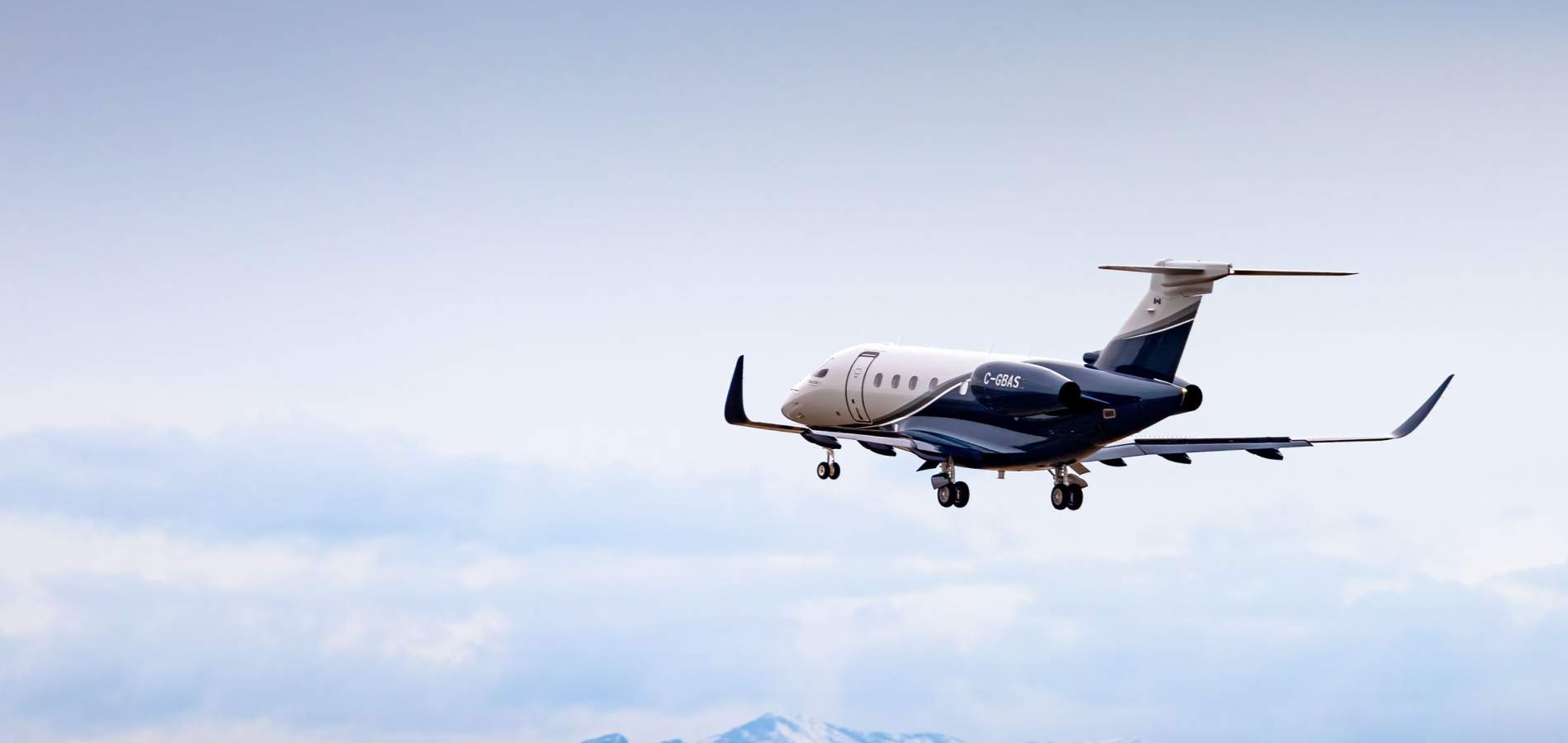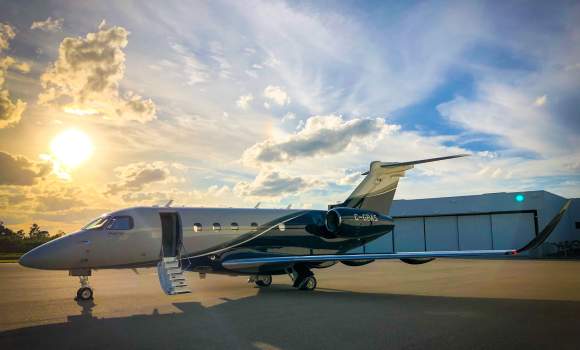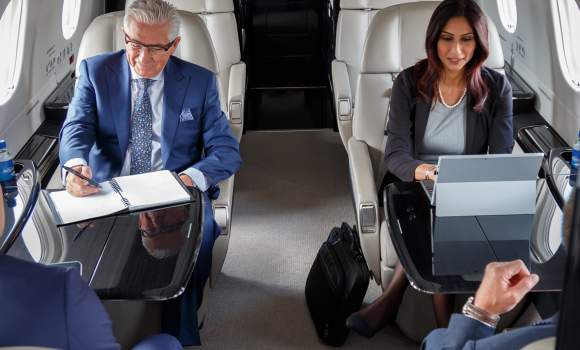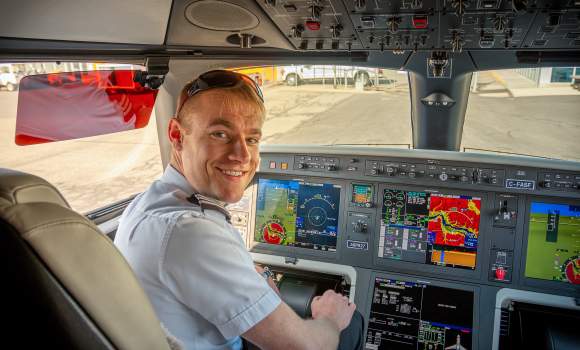Here's helpful advice for choosing the corporate aircraft that will maximize efficiency, profits and productivity.
For companies that are looking to transport employees safely and efficiently, business aviation can’t be beat.
“Business aviation is simply a tool that does work for an organization,” said Anthony Norejko, President & CEO of the Canadian Business Aviation Association (CBAA). “There is a duty of care obligation there with how your folks travel and ensuring that what they undertake on the organization’s behalf is done as safely and securely as possible.”
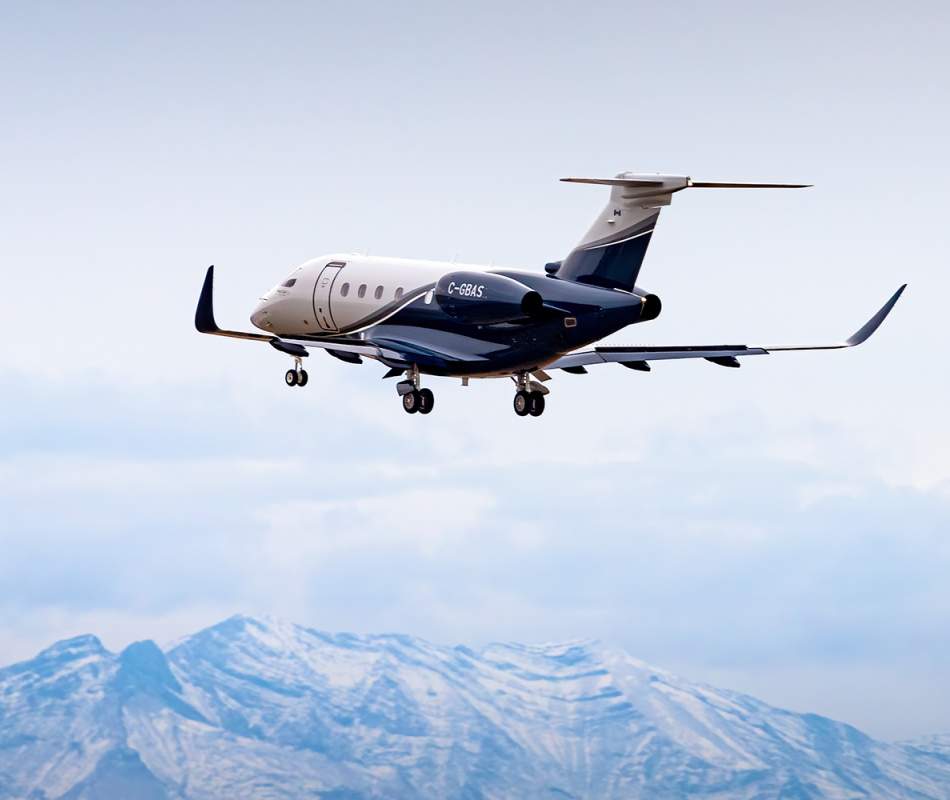
Get Where You're Going Safely, Reliably & Efficiently
Business aviation offers company personnel a private 'flying office' where sensitive information can be discussed freely— and connectivity capabilities are on par with ground-based communications systems—meaning that flight time is not lost time when it comes to productivity.
Executive Summary
Companies that use business aircraft outperform those that don’t.
A 2017 study by Nexa Advisors found that business aviation is a proven competitive advantage for North America’s biggest corporations. In fact, among the companies listed on the S&P 500 and the TSX 60 – representing North America’s 560 largest publicly-traded companies – those who use business aviation clearly demonstrated increased enterprise value, both in share amount and share appreciation.
“This is because business aircraft leverage key employee productivity, accelerate transactional closings, and boost customer interaction,” asserts the Nexa report.
According to the Canadian Business Aviation Association (CBAA) in 2017, Canada’s business aircraft and business aviation manufacturers represented a powerful economic engine that generated a total impact of $5.8 billion in annual gross domestic product (GDP). Business aviation is a “corporate advantage that connects Canadian entrepreneurs and corporations to remote locations and world markets,” said the CBAA.
Likewise, the 'No Plane, No Gain' campaign sponsored jointly by the U.S. National Business Aviation Association (NBAA) and the General Aviation Manufacturers Association (GAMA) notes that 95 per cent of Fortune magazine’s '100 Best Places to Work' are business aircraft users.
The campaign points out that business aircraft offer companies a host of tangible benefits, including:
- Time savings for key employees
- Increased productivity
- Acceleration of strategic transactions
- Intellectual property protection
- Improved customer service
In total, there are an estimated 1,900 business aviation aircraft in Canada, including both airplanes and helicopters, according to a report by InterVISTAS Consulting Inc. TSX 60 companies that use them outperform those that don’t by 43 per cent.
So, what do users of these aircraft know that others don’t? And, once you understand the value proposition of a business aircraft, how in the world do you choose the one that is right for you? After all, Jet Advisors indicates there are more than 100 types of business jets to choose from, across a variety of sizing and capabilities categories.
In this paper, we’ll examine the key drivers supporting business aviation and important questions to consider before selecting a company aircraft. Finally, we’ll look at the role business aircraft play in an increasingly globalized world and how the industry is making great strides in advancing sustainable operations.
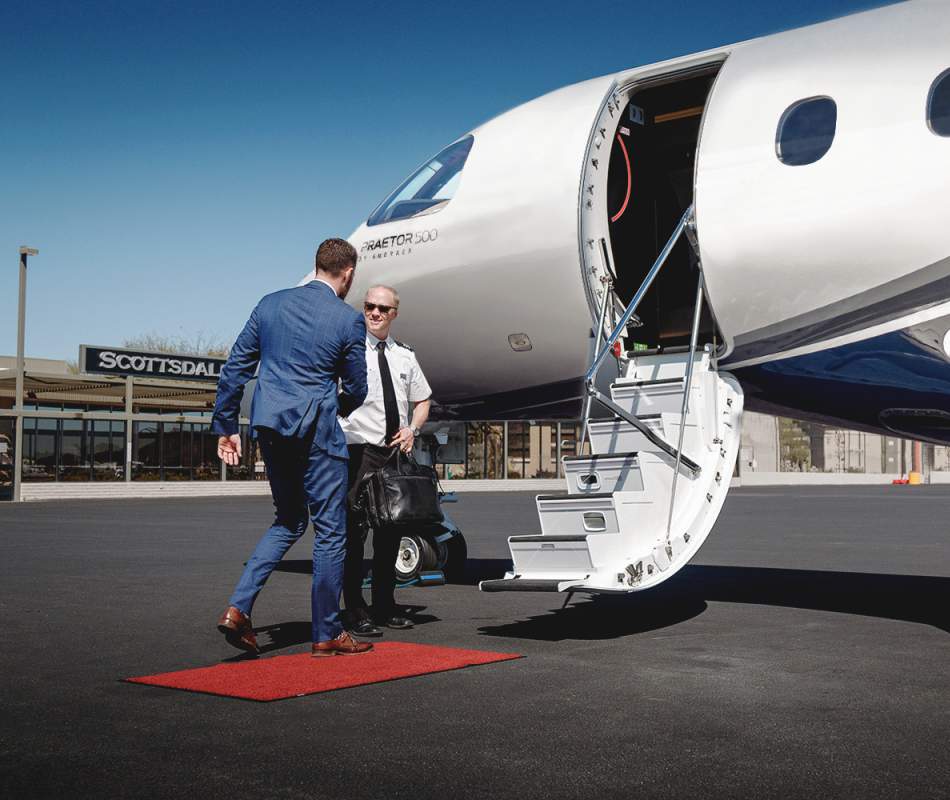
Benefits of Business Aircraft
- Employee time savings
- Improved productivity
- Transaction acceleration
- Intellectual property protection
- Higher customer retention/capture
- Risk management
- Employee safety and security
- Social responsibility
The Business Case for Business Aviation
A growing force in Canada...
Business aviation has been a growing force in Canada since the first company-owned aircraft was registered in June 1920, writes Frederick K. Larkin in Skies Magazine. By 1961, the Canadian Business Aviation Association (CBAA) was formed to represent the interests of companies operating these aircraft.
Today, there are an estimated 1,900 business aircraft in Canada, including 500+ jets. Twenty* of those jets are operated by the country’s leader in Fractional Jet Ownership, AirSprint Private Aviation. According to James Elian, AirSprint’s President & CEO, the coast-to-coast operator has enjoyed unprecedented growth throughout 2020 and 2021, as more and more companies come to understand the business case for business aviation.

“Canada is a big country,” said Elian. “One of the key uses for a business aircraft is transporting employees and customers to multiple sites. It’s a wonderful business tool if you have a remote site and are trying to get key customers, suppliers or buyers out to see the nature of your operation. Many people buy only what they can touch and feel.”
In general, there are six primary uses for business aircraft, according to a 2017 report from NEXA Advisors:
- Employee transportation
- Customer transportation
- Supplier transportation
- Transportation of cargo, parts and mail
- Humanitarian or charitable transportation
- Direct applications such as photography, remote sensing or third-party charter
Elian pointed out that a business aircraft allows companies to move cargo and people according to their own schedule and to access more remote destinations. In the U.S., for example, the NBAA reports that business aviation reaches 10 times more airports than the airlines do. It’s a similar story here in Canada, especially with post-COVID airline route reductions.
“Looking at historical financial performance, you find that users of business aircraft have a higher total shareholder return, higher market cap growth, higher revenue and return, and higher profitability,” said Elian.
He described what he calls the 'mobility break' – the point where a company’s cost-benefit analysis tips in favour of private jet travel.
“For routine work, you can often use virtual tools to accomplish your mission. But for things that really matter to a company, such as developing relationships, deploying specialist teams, negotiating deal closings – all high touch, time critical examples – business aircraft allow you to achieve those things quite effectively.”
Safe and secure...
For companies that are looking to transport employees safely and efficiently, business aviation can’t be beat.
“Business aviation is simply a tool that does work for an organization,” said Anthony Norejko, CBAA president and CEO. “There is a duty of care obligation there with how your folks travel and ensuring that what they undertake on the organization’s behalf is done as safely and securely as possible.”
In fact, air travel is among the safest methods of transportation. Business aircraft flown by a two-person professional crew have a comparable safety record to commercial airlines. From a health perspective, business aviation delivers a much safer travel experience, with far fewer touchpoints and less exposure to viruses.
As for security, business aviation offers company personnel a private 'flying office' where sensitive information can be discussed freely. Additionally, most modern business aircraft feature connectivity capabilities that are on par with ground-based communications systems – meaning that flight time is not lost time when it comes to productivity.
* At the time of publishing the white paper, there were twenty jets in the AirSprint fleet. As of February 2022, there are now twenty-four jets.
Aircraft Selection Considerations
Prior to choosing an aircraft to serve your company, there are some important factors to consider.
 1. Your Mission
1. Your Mission
“If you buy an aircraft to do 90 per cent of what you need it to do, you will be in that aircraft for the long term,” said the CBAA’s Norejko. “The mistake people make is they buy something far greater than what they actually need. Be sure to right-size your solution.”
Consider what you want to accomplish with your company aircraft. Will you be flying great distances overseas? Landing on short or unpaved strips? Who (and how many) will be travelling on board and what comfort level and amenities are required? Will you need a meeting table, full internet connectivity, rest facilities for passengers and/or crew, or even a shower?
What avionics equipment will be required in the cockpit to allow you to travel where you need to go? How much baggage and cargo capacity is required to complete the majority of your missions?
Understand your requirements and apply them to the field of contenders to weed out aircraft that will not be suitable.
 2. Cost and Budget
2. Cost and Budget
“This is a big one,” said Elian. “Your financial ability to pay for an aircraft will naturally limit what you can buy. Cost is a reality, whether the initial capital cost or the operational day-to-day cost.”
Aside from the purchase price of the aircraft, there are several related financial expenditures, including fuel, maintenance, hangar storage, management fees, insurance, crew salaries and training and avionics memberships/database subscriptions.
Investigate every aspect of aircraft ownership in order to understand the big picture cost of ownership – and compare that to your budget.
 3. Human & Other Factors
3. Human & Other Factors
“Aviation is a high reliability industry and there are certain associated risks that can be mitigated,” said AirSprint’s Elian.
Assess the human factors of potential aircraft:
- Should you operate with one pilot (if permitted) or two?
- What safety equipment is mandatory and what is nice to have?
- What does the historical safety record show about your aircraft type?
- Fatigue levels are impacted by noise, cabin pressurization and the availability of fresh air – how does your potential aircraft perform?
In addition, there are other considerations that deserve a buyer’s attention. These include an aircraft’s environmental performance, including noise level, emissions and fuel burn. Are there political or international policy considerations to consider? For example, perhaps your typical mission calls for you to overfly a country where you cannot land.

A True North American Solution
“A large segment of the Canadian economy is export-based. There is a high demand for businesses to send people to and from the United States. With the hub and spoke airline system, it can take a long time to visit the more remote locations. With business aviation, your people can be home for dinner and you’ll save on expenses like rental cars, meals and hotels.”
James Elian, AirSprint
Weighing Your Aircraft Options
Once you have a clear understanding of your mission, the costs involved in aircraft ownership and your budget, as well as human and environmental factors, it’s time to make a decision.
AirSprint’s Elian developed a weighted score approach that applies a qualitative and quantitative framework to the aircraft selection process.
“This is the critical step,” he explained. “Take the right amount of time to understand what you need the aircraft to do.”
Elian’s system calls for buyers to employ five primary selection steps: consideration item weighting, secondary category weighting, determination of company requirements, consideration item scoring and analysis of scoring.
“You are forced to choose and you have to rank each item based on its weighting,” he explained. “For example, perhaps you are quite sensitive on capital costs but ongoing costs are less concerning.”
Regardless, choosing the right aircraft for your company is no easy task. Elian recommends that buyers work with experts who can guide them during the process.
Besides outright purchase, there are many other options – including AirSprint’s Fractional Jet Ownership packages that offer Capital Purchase or attractive 5-Year Leasing options.
“Aviation is highly technical,” said Elian. “It’s among the most regulated industries in Canada and North America. I can’t tell you how many times I’ve spoken to people who ended up with an aircraft that doesn’t do what they thought it would do. It’s so important to do your research and seek out an expert. There are more than 80 considerations when it comes to choosing an aircraft and any one of those can impact your ultimate experience.”
AirSprint used Elian’s weighted score approach in 2012 when it replaced its fleet of single-engine Pilatus PC-12 turboprops with the Cessna Citation CJ2+ business jet. Later, his decision-making matrix was employed in the company’s selection of the Embraer Legacy 450.
“My advice would be to start out thinking specifically about what you need, and then reach out to two or three aviation experts,” he said. “Have an initial conversation and see what info they can provide. Then, choose the one that seems to understand your requirements the best.”
Again, Elian stressed the importance of identifying and understanding your company's needs.
“Choosing the right aircraft is critical – the one that satisfies the vast majority of your missions but not necessarily 100 per cent of them. There is a return on investment with business aircraft, and for many companies it’s not hard to justify.”
Business Aviation in Canada
Q & A with CBAA’s Anthony Norejko

Industry leader Anthony Norejko, president and CEO of CBAA, shares his insight into business aviation in Canada.
-
Why does business aviation make sense in Canada?
The population of Canada is effectively the same as the state of California. We are blessed with a lot of geography and we are spread out. Because of COVID-19, commercial airlines are consolidating some routes and eliminating others. It’s a simple math exercise: Time is the only thing you can’t renew. To a savvy individual conducting a time/cost-benefit analysis right now, it’s clear that business aviation makes sense.
-
How does business aviation contribute to the Canadian economy?
The importance of Canadian aerospace and aviation is clear. We have aircraft OEMs, simulator manufacturers, engine manufacturers – a long list of known and respected names. Business aviation represents $12 billion of total annual economic output for Canada and about 50,000 high-paying jobs. Every day, business aviation generates $33 million in GDP.
-
What is the role of business aviation in an increasingly globalized world?
It’s clear that for the things that matter, business aviation will get you there safely, reliably and efficiently. The pace of change is relentless. The video conference may destroy the airline business model – but for the meetings that matter, business aviation is the way to get there.
-
Let’s talk about sustainability. Where is business aviation in the quest to be green?
The reality is that civil aviation overall is responsible for two per cent of global emissions – and of that, business aviation represents 0.04 per cent. Part of CBAA’s role is to educate the government about business aircraft, which often employ the very latest technologies. We were the first to use fuel-saving winglets and composite design, along with engines that become cleaner and greener every year. In fact, new aircraft are 80 per cent more fuel efficient than the first jets made in the 1950s. The technology business aviation invests in these areas is second to none. I think you will see our sector lead in leveraging machine learning for smart routing and we will play a big role in the electrification of regional aircraft. I think we will also see a net zero business aviation commitment and we will lead by example.
Conclusion
There's never been a better time to harness the power of business aviation. Aircraft ownership delivers a proven competitive advantage, allowing companies to maximize key employee productivity, accelerate the conclusion of important deals, and improve the quality of customer interactions.
Geographically, Canada is a big country. Business aircraft enable organizations to transport staff, customers and supplies quickly and efficiently. In addition, private jets can access many more destinations than the airlines. They allow for a customized travel schedule with far fewer touchpoints and less exposure to COVID-19 and other viruses. For companies looking to transport employees safely and efficiently, business aviation is the way to go.
However, deciding to acquire a business aircraft is only the first step. From there, it's essential to carefully consider your typical mission, costs, budget and other relevant factors. It's crucial to make the right decision the first time around.
The private aviation experts at AirSprint are ready to help you explore your options on the path to aircraft ownership. Take the first step and contact us today.
Ready for the ultimate corporate advantage?
© 2021 AirSprint Inc. All rights reserved. This paper was produced for AirSprint by Mustang Media Writing & Editorial Services
